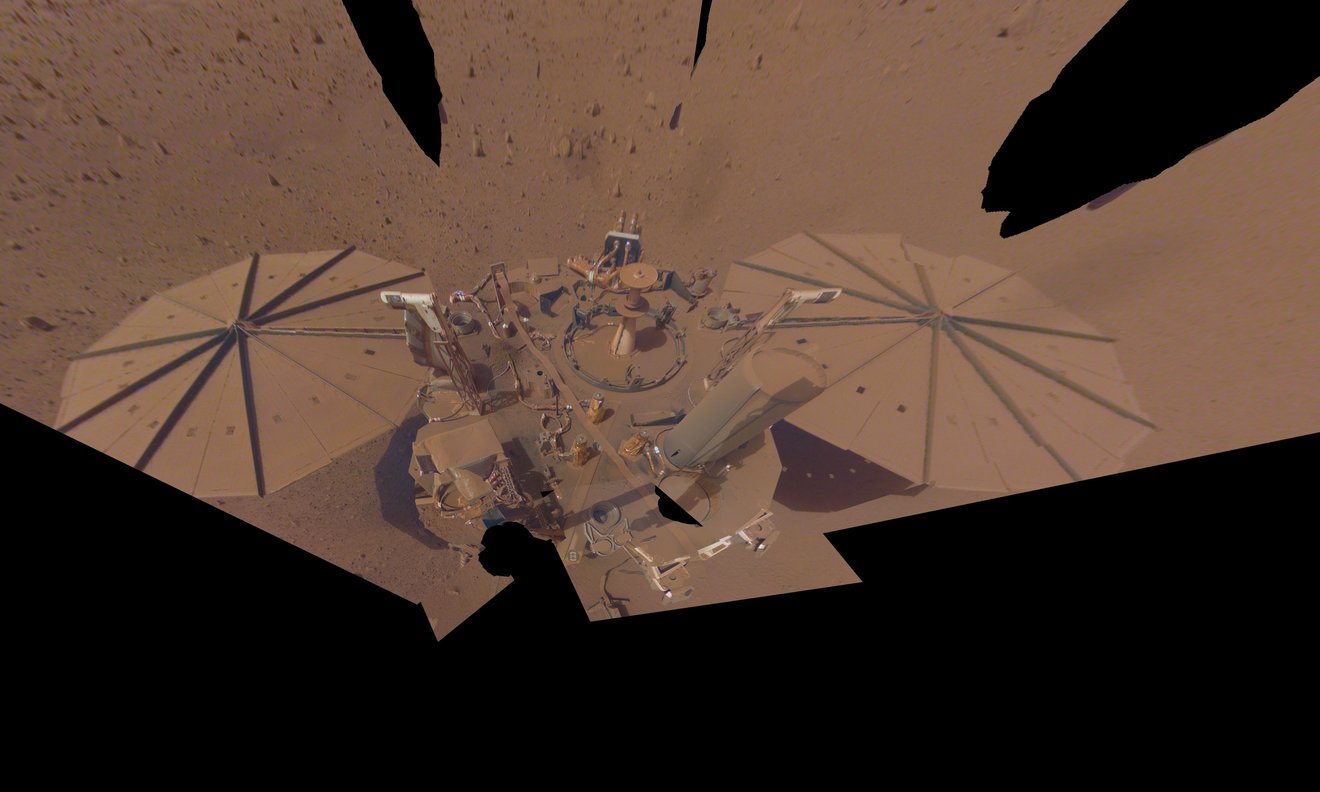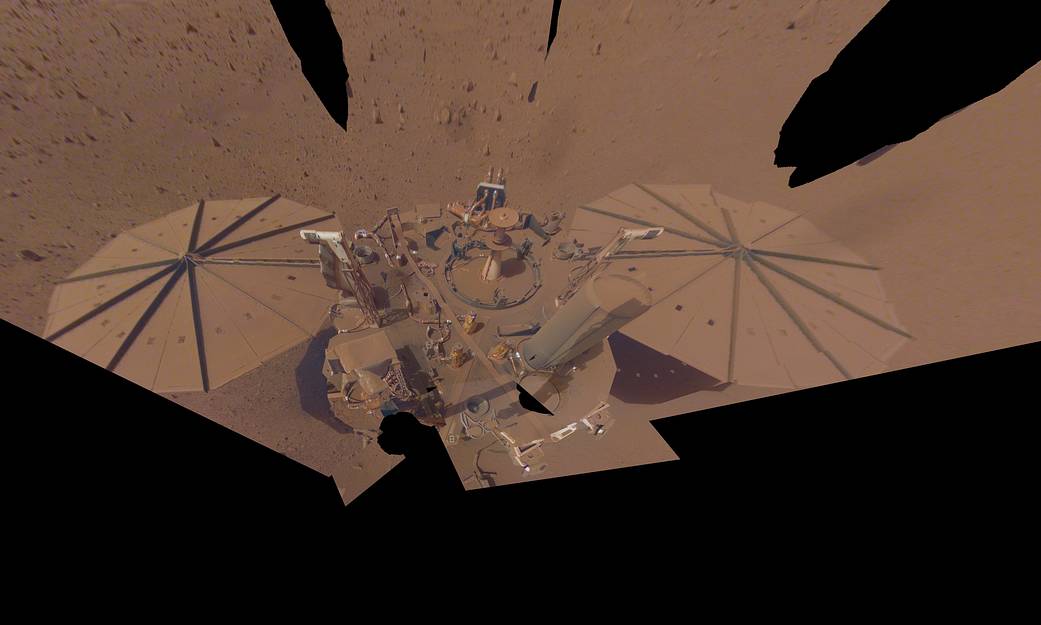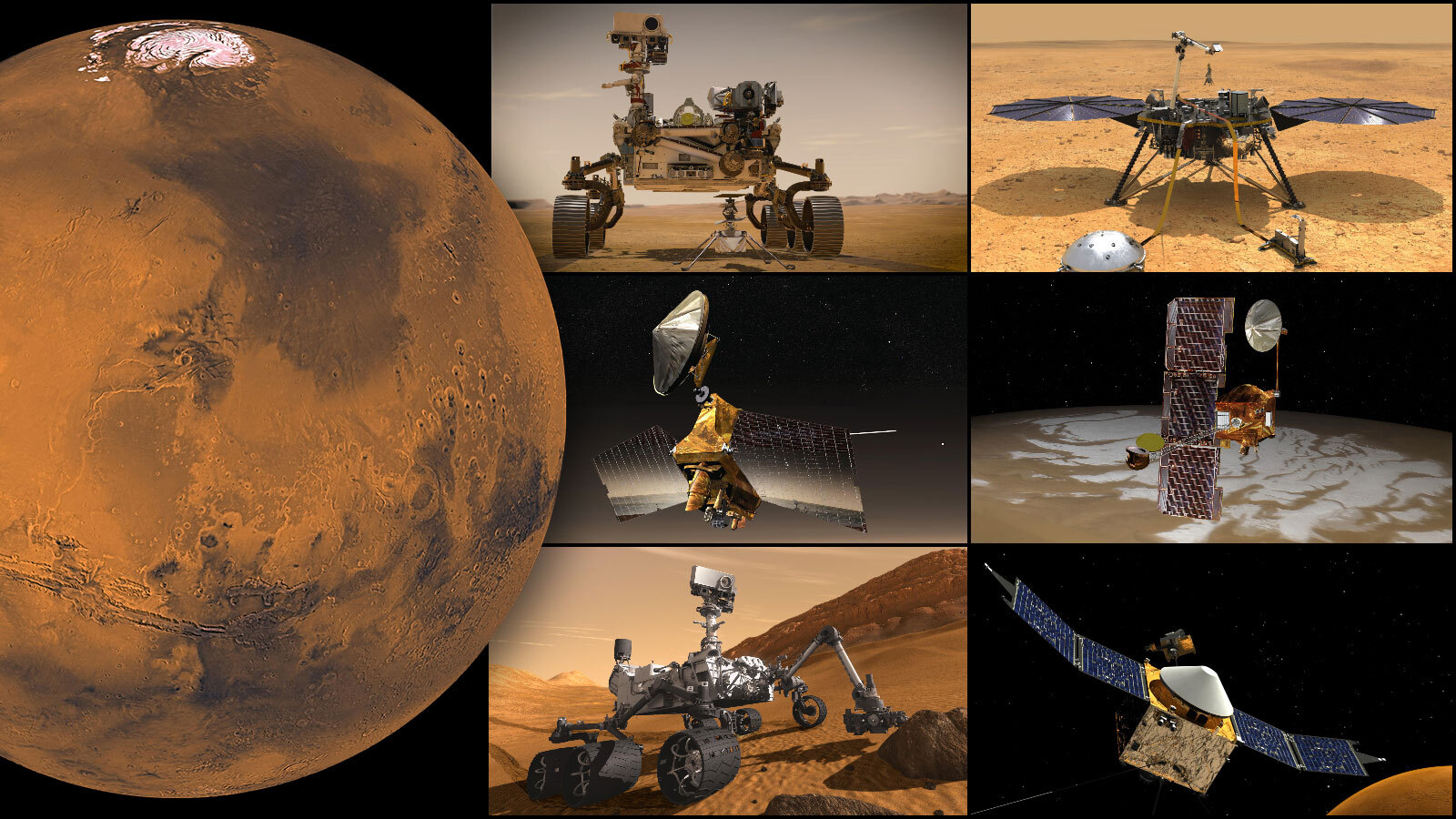Its solar panels are caked with dust and the batteries are running out of juice, but NASA’s InSight Mars lander continues to soldier forth collecting more science about the Red Planet until its very last beep. To conserve energy, InSight was projected to shut down its seismometer—its last operational science instrument—by the end of June, hoping to survive on its remaining power until December. The seismometer has been the key instrument designed to measure marsquakes, which it has been recording since it touched down on Mars in 2018, and recently recorded a 5.0-magnitude quake, the biggest yet.
Continue reading “Despite its draining power, NASA’s InSight Mars lander is determined to squeeze as much science as it can until the very last moment”This is the Last Selfie InSight Will Ever Take
Few things in life captivate us more than looking at images from other planets, no matter how dull these images might seem. This is especially true for Mars, as it’s where we’ve sent the most robots to explore its cold and dry surface. The very first image from the surface of Mars in July 1976 was nothing more than the Viking 1 lander’s footpad and some rocks, but no one cared about these mundane details because we were looking at an image from Mars. We were looking at the surface of another world for the first time in human history, and not only were we captivated by it, but we wanted more.
Continue reading “This is the Last Selfie InSight Will Ever Take”Communication With Mars is About to Become Impossible (for two Weeks)
Every two years, Mars enters what is known as a “Solar Conjunction,” where its orbit takes it behind the Sun relative to Earth. During these periods, the hot plasma regularly expelled by the Sun’s corona can cause interference with radio signals transmitted between Earth and Mars. To avoid signal corruption and the unexpected behaviors that could result, NASA and other space agencies declare a moratorium on communications for two weeks.
What this means is that between Oct. 2nd and Oct. 16th, all of NASA’s Mars missions will experiencing what is known as a “commanding moratorium.” This will consist of NASA sending a series of simple commands to its missions in orbit, which will then be dispatched to landers and rovers on the surface. These simple tasks will keep all of the robotic Martian explorers busy until regular communications can be established.
Continue reading “Communication With Mars is About to Become Impossible (for two Weeks)”First Interplanetary CubeSats to Launch on NASA’s 2016 InSight Mars Lander
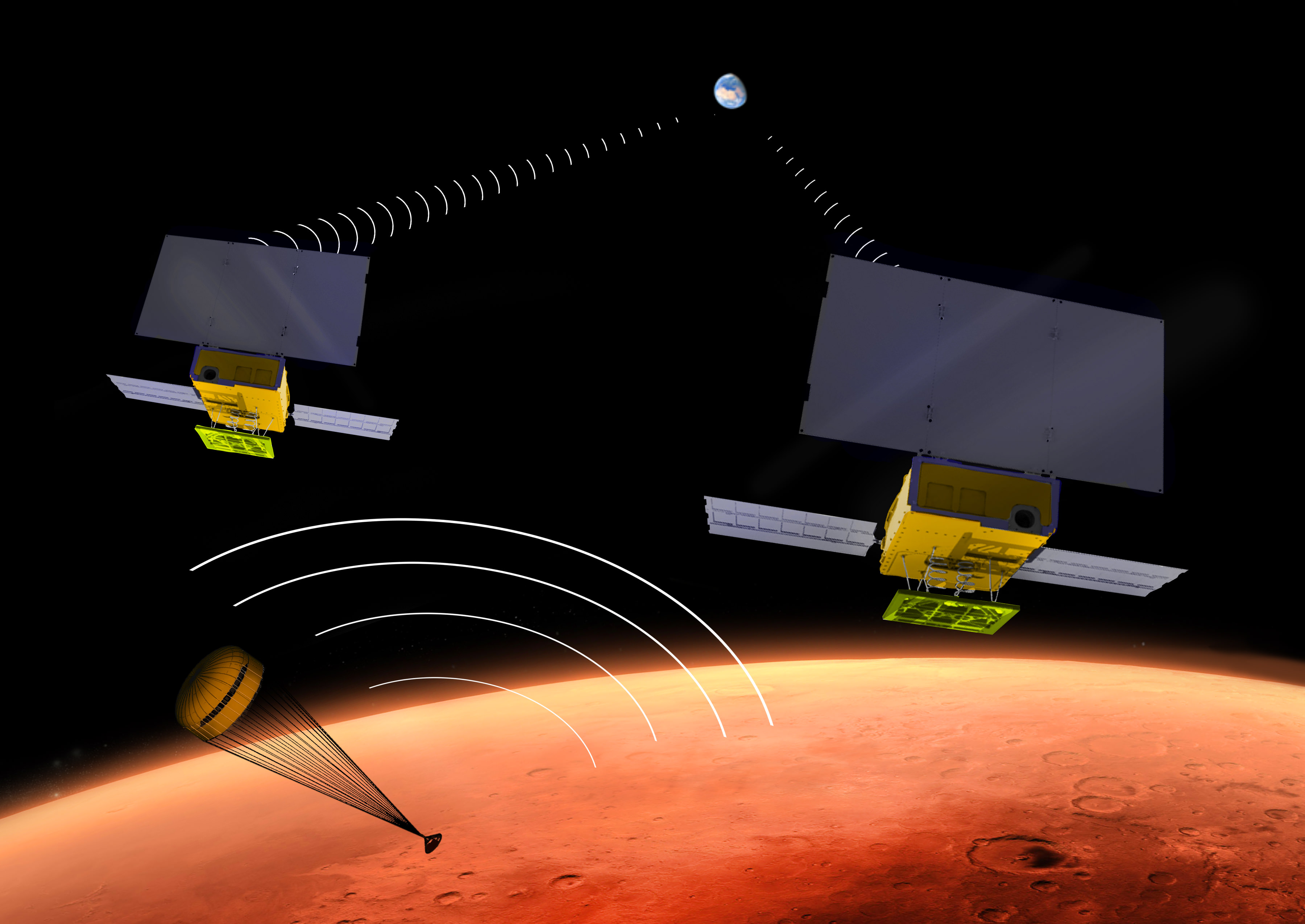
NASA’s two small MarCO CubeSats will be flying past Mars in 2016 just as NASA’s next Mars lander, InSight, is descending to land on the surface. MarCO, for Mars Cube One, will provide an experimental communications relay to inform Earth quickly about the landing. Credits: NASA/JPL-Caltech
See fly by and cubesat spacecraft graphics and photos below[/caption]
CubeSats are taking the next great leap for science – departing Earth and heading soon for the fourth rock from the Sun.
For the first time, two tiny CubeSat probes will launch into deep space in early 2016 on their first interplanetary expedition – aiming for the Red Planet as part of an experimental technology relay demonstration project aiding NASA’s next Mission to Mars; the InSight lander.
NASA announced the pair of briefcase-sized CubeSats, called Mars Cube One or MarCO, as a late and new addition to the InSight mission, that could substantially enhance communications options on future Mars missions. They were designed and built by NASA’s Jet Propulsion Laboratory (JPL), Pasadena, California.
InSight, which stands for Interior Exploration Using Seismic Investigations, Geodesy and Heat Transport, is a stationary lander. It will join NASA’s surface science exploration fleet currently comprising of the Curiosity and Opportunity missions which by contrast are mobile rovers.
InSight is the first mission to understand the interior structure of the Red Planet. Its purpose is to elucidate the nature of the Martian core, measure heat flow and sense for “Marsquakes.”
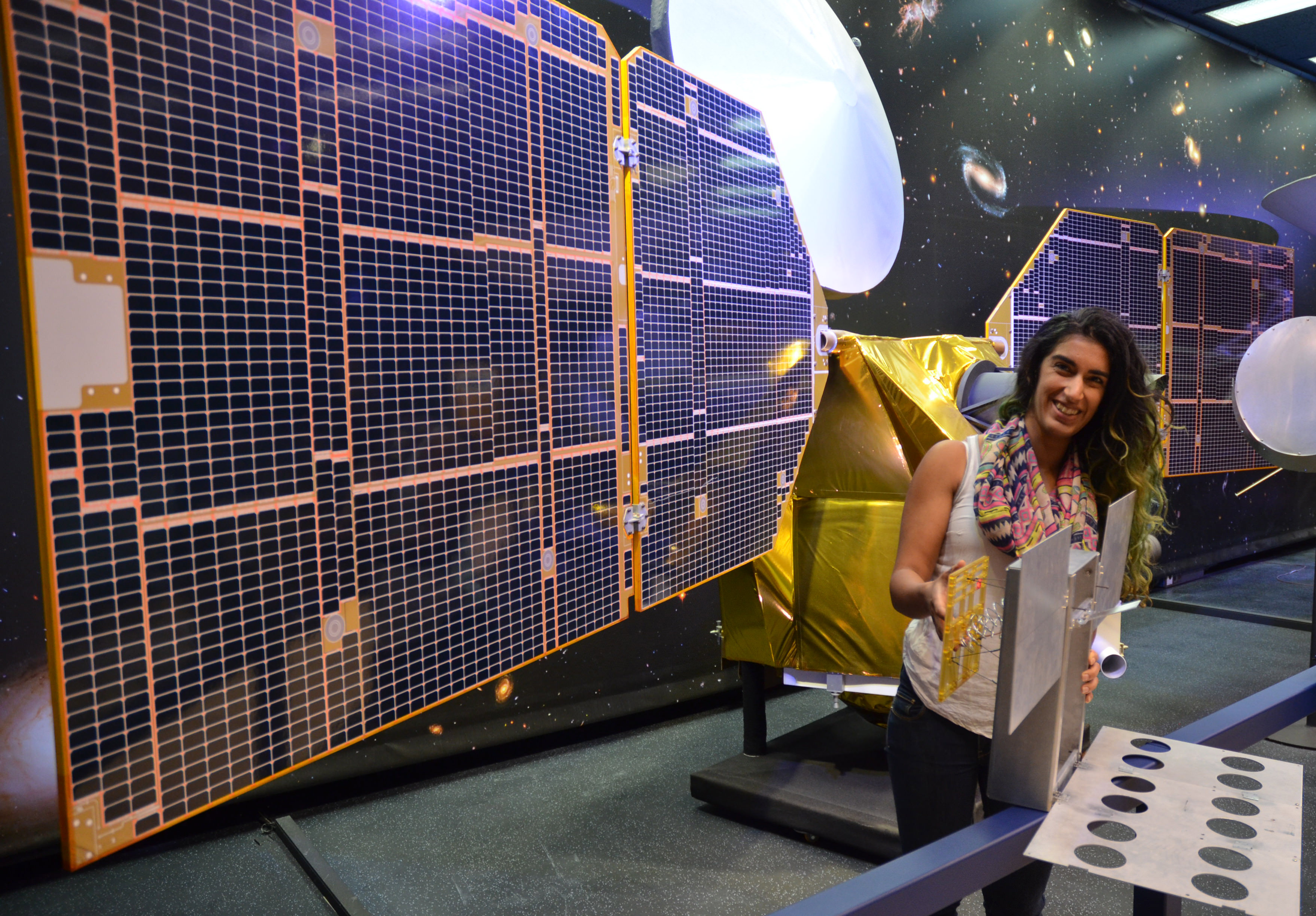
Because of their small size – roughly 4 inches (10 centimeters) square) – and simplicity using off-the-shelf components, they are a favored platform for university students and others seeking low cost access to space – such as the Planetary Society’s recently successful Light Sail solar sailing cubesat demonstration launched in May. Six units are combined together to create MarCO.
Over the past few years many hundreds of cubesats have already been deployed in Earth orbit – including many dozens from the International Space Station (ISS) – but these will be the first going far beyond our Home Planet.
Data relayed by MarCO at 8 kbps in real time could reveal InSight’s fate on the Martian surface within minutes to mission controllers back on Earth, rather than waiting for a potentially prolonged period of agonizing nail-biting lasting an hour or more.
The two probes, known as MarCO-A and MarCO-B, will operate during InSight’s highly complex entry, descent and landing (EDL) operations as it descends through the thin Martian atmosphere. Their function is merely to quickly relay landing data. But the cubesats will have no impact on the ultimate success of the mission. They will intentionally sail by but not land on Mars.
“MarCO is an experimental capability that has been added to the InSight mission, but is not needed for mission success,” said Jim Green, director of NASA’s planetary science division at the agency’s headquarters in Washington, in a statement.
The MarCO Cubesats will serve as a test bed for a revolutionary communications mode that seeks to quickly relay data back to Earth about the status of InSight – in real time – as it plummets down to the Red Planet for the “Seven Minutes of Terror” that hopefully climaxes with a soft landing.
The MarCO duo will fly by past Mars at a planned distance and altitude of about 3,500 kilometers as InSight descends towards the surface during EDL operations. They will rapidly retransmit signals coming from the lander in real time, directly back to NASA’s huge Deep Space Network (DSN) receiving dish antennas back on Earth.
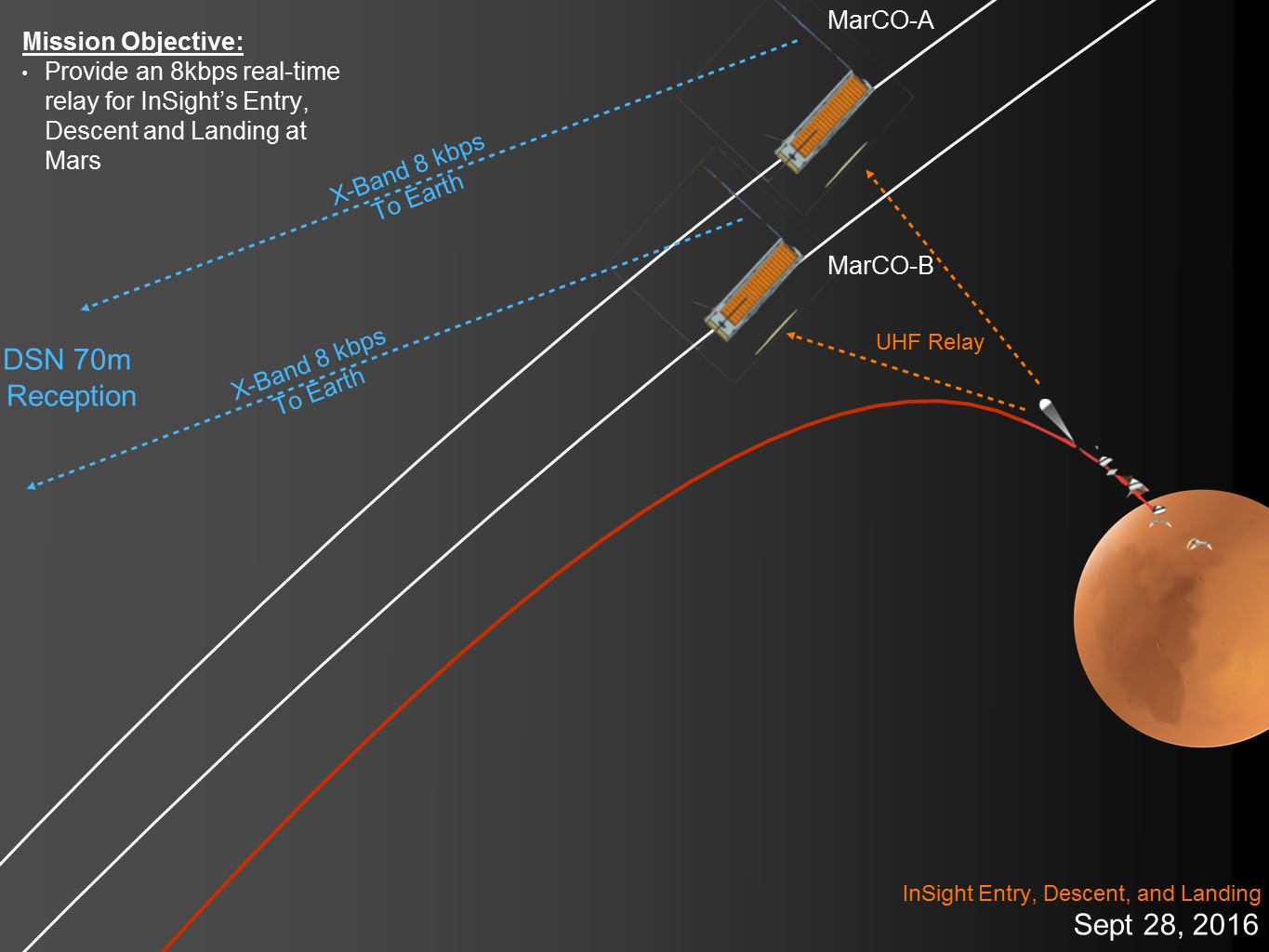
MarCO cubesats fly by trajectory for rapid communications relay as NASA’s InSight spacecraft lands on Mars in September 2016. Credit: NASA/JPL-Caltech
For this flight, six cubesats will be joined together to provide the additional capability required for the journey to Mars and to accomplish their communications task.
The six-unit MarCO CubeSat has a stowed size of about 14.4 inches (36.6 centimeters) by 9.5 inches (24.3 centimeters) by 4.6 inches (11.8 centimeters) and weighs 14 kilograms.
The solar powered probes will be outfitted with UHF and X-band communications gear as well as propulsion, guidance and more.
The overall cost to design, build, launch and operate MarCO-A and MarCO-B is approximately $13 million, a NASA spokesperson told Universe Today.
InSight and MarCO are slated to blastoff together on March 4, 2016 atop a United Launch Alliance Atlas V rocket from Vandenberg Air Force Base, California.
After launch, both MarCO CubeSats will separate from the Atlas V booster and travel along their own trajectories to the Red Planet.
“MarCO will fly independently to Mars,” says Green.
They will be navigated independently from InSight. They will all reach Mars at approximately the same time for InSight’s landing slated for Sept. 28, 2016.
MarCO’s two solar panels and two radio antennas will unfurl after being released from the Atlas booster. The high-gain, X-band antenna is a flat panel engineered to direct radio waves the way a parabolic dish antenna does,” according to a NASA description.
The softball-size radio “provides both UHF (receive only) and X-band (receive and transmit) functions capable of immediately relaying information received over UHF.”

During EDL, InSight will transmit landing data via UHF radio to the MarCO cubesats sailing past Mars as well as to NASA’s Mars Reconnaissance Orbiter (MRO) soaring overhead.
MarCO will assist InSight by receiving the lander information transmitted in the UHF radio band and then immediately forward EDL information to Earth using the X-band radio. By contrast, MRO cannot simultaneously receive information over one band while transmitting on another, thus delaying confirmation of a successful landing possibly by an hour or more.
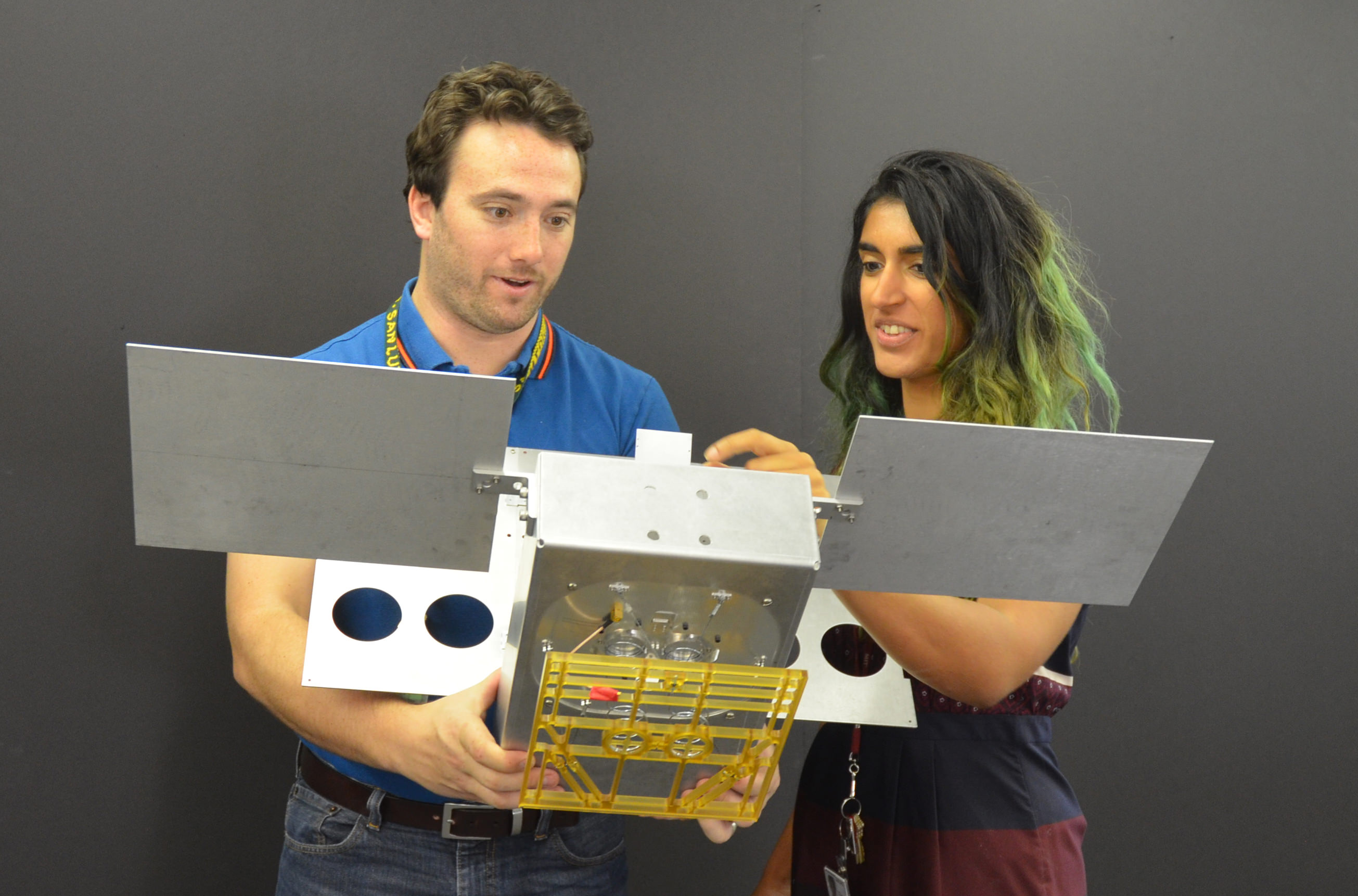
“Ultimately, if the MarCO demonstration mission succeeds, it could allow for a “bring-your-own” communications relay option for use by future Mars missions in the critical few minutes between Martian atmospheric entry and touchdown,” say NASA officials.
It’s also very beneficial and critical to the success of future missions to have a stream of data following the progress of past missions so that lessons can be learned and applied, whatever the outcome.
“By verifying CubeSats are a viable technology for interplanetary missions, and feasible on a short development timeline, this technology demonstration could lead to many other applications to explore and study our solar system,” says NASA.
InSight will smash into the Martian atmosphere at high speeds of approximately 13,000 mph in September 2016 and then decelerate within a few minutes for landing via a heat shield, retro rocket and parachute assisted touchdown on the plains at flat-lying terrain at “Elysium Planitia,” some four degrees north of Mars’ equator, and a bit north of the Curiosity rover.
As I reported in recently here, InSight has now been assembled into its flight configuration and begun a comprehensive series of rigorous environmental stress tests that will pave the path to launch in 2016 on a mission to unlock the riddles of the Martian core.
The countdown clock is ticking relentlessly towards liftoff in less than nine months time in March 2016.

Stay tuned here for Ken’s continuing Earth and planetary science and human spaceflight news.
NASA’s Journey to Mars Ramps Up with InSight, Key Tests Pave Path to 2016 Lander Launch

NASA’s ‘Journey to Mars’ is ramping up significantly with ‘InSight’ – as the agency’s next Red Planet lander has now been assembled into its flight configuration and begun a comprehensive series of rigorous and critical environmental stress tests that will pave the path to launch in 2016 on a mission to unlock the riddles of the Martian core.
The countdown clock is ticking relentlessly and in less than nine months time, NASA’s InSight Mars lander is slated to blastoff in March 2016.
InSight, which stands for Interior Exploration Using Seismic Investigations, Geodesy and Heat Transport, is a stationary lander. It will join NASA’s surface science exploration fleet currently comprising of the Curiosity and Opportunity missions which by contrast are mobile rovers.
But before it will even be allowed to get to the launch pad, the Red Planet explorer must first prove its mettle and show that it can operate in and survive the harsh and unforgiving rigors of the space environment via a battery of prelaunch tests. That’s an absolute requirement in order for it to successfully carry out its unprecedented mission to investigate Mars deep interior structure.
InSight’s purpose is to elucidate the nature of the Martian core, measure heat flow and sense for “Marsquakes.” These completely new research findings will radically advance our understanding of the early history of all rocky planets, including Earth and could reveal how they formed and evolved.
“Today, our robotic scientific explorers are paving the way, making great progress on the journey to Mars,” said Jim Green, director of NASA’s Planetary Science Division at the agency’s headquarters in Washington, in a statement.
“Together, humans and robotics will pioneer Mars and the solar system.”
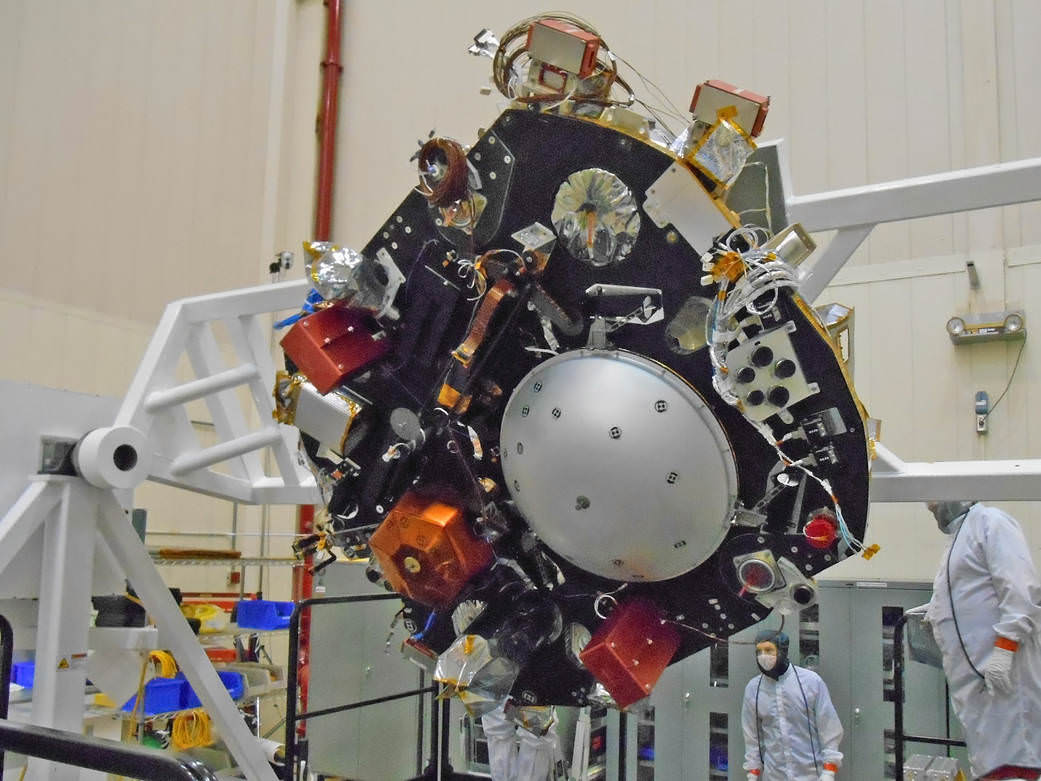
The launch window for InSight opens on March 4 and runs through March 30, 2016.
InSight will launch atop a United Launch Alliance (ULA) Atlas V rocket from Vandenberg Air Force Base, California.
InSight counts as NASA’s first ever interplanetary mission to launch from California.
The car sized probe will touch down near the Martian equator about six months later in the fall of 2016.
The prime contractor for InSight is Lockheed Martin Space Systems in Denver, Co and the engineering and technical team recently finished assembling the lander into its final configuration.
So now the time has begun to start the shakedown that literally involve “shaking and baking and zapping” the spacecraft to prove its ready and able to meet the March 2016 launch deadline.
During the next seven months of environmental testing at Lockheed’s Denver facility, “the lander will be exposed to extreme temperatures, vacuum conditions of nearly zero air pressure simulating interplanetary space, and a battery of other tests.”
“The assembly of InSight went very well and now it’s time to see how it performs,” said Stu Spath, InSight program manager at Lockheed Martin Space Systems, Denver, in a statement.
“The environmental testing regimen is designed to wring out any issues with the spacecraft so we can resolve them while it’s here on Earth. This phase takes nearly as long as assembly, but we want to make sure we deliver a vehicle to NASA that will perform as expected in extreme environments.”
The first test involves “a thermal vacuum test in the spacecraft’s “cruise” configuration, which will be used during its seven-month journey to Mars. In the cruise configuration, the lander is stowed inside an aeroshell capsule and the spacecraft’s cruise stage – for power, communications, course corrections and other functions on the way to Mars — is fastened to the capsule.”
After the vacuum test, InSight will be subjected to a series of tests simulating the vibrations of launch, separation and deployment shock, as well as checking for electronic interference between different parts of the spacecraft and compatibility testing.
Finally, a second thermal vacuum test will expose the probe “to the temperatures and atmospheric pressures it will experience as it operates on the Martian surface.”
The $425 million InSight mission is expected to operate for about two years on the Martian surface.

InSight is an international science mission and a near duplicate of NASA’s successful Phoenix Mars landing spacecraft, Bruce Banerdt, InSight Principal Investigator of NASA’s Jet Propulsion Laboratory (JPL), Pasadena, California, told Universe Today.
“InSight is essentially built from scratch, but nearly build-to-print from the Phoenix design,” Banerdt, of NASA’s Jet Propulsion Laboratory (JPL) in Pasadena , Calif, told me. The team can keep costs down by re-using the blueprints pioneered by Phoenix instead of creating an entirely new spacecraft.
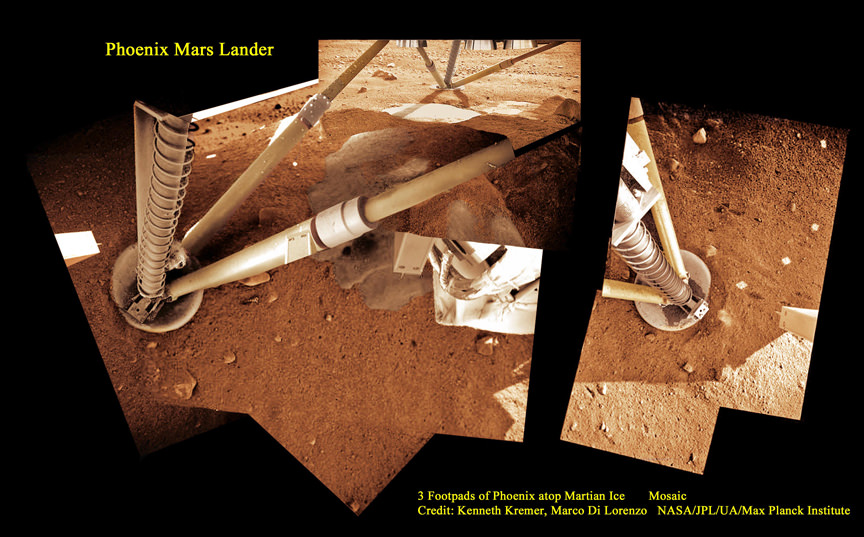
It is funded by NASA’s Discovery Program as well as several European national space agency’s and countries. Germany and France are providing InSight’s two main science instruments; HP3 and SEIS through the Deutsches Zentrum für Luft- und Raumfahrt. or German Aerospace Center (DLR) and the Centre National d’Etudes Spatiales (CNES).
“The seismometer (SEIS, stands for Seismic Experiment for Interior Structure) is from France (built by CNES and IPGP) and the heat flow probe (HP3, stands for Heat Flow and Physical Properties Probe) is from Germany (built by DLR),” Banerdt explained.
SEIS and HP3 are stationed on the lander deck. They will each be picked up and deployed by a robotic arm similar to that flown on Phoenix with some modifications.
Stay tuned here for Ken’s continuing Earth and planetary science and human spaceflight news.

